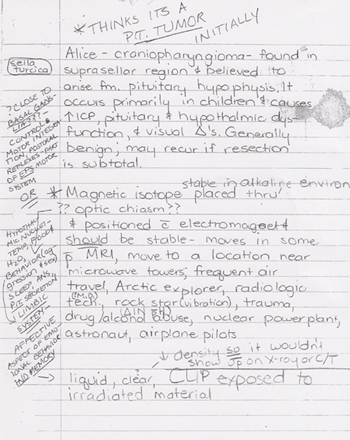Seeing Patients with Science Fiction
In addition to texturing her poetry, seeing patients also animates Terri’s engagement with science fiction. A fan of science fiction since her late teens, Terri’s engagement with science fiction has continued throughout her life. Terri loved reading the science fiction of Ray Bradbury, Stephen King, Michael Crichton, and Robin Cook. Terri’s experiences in an open-heart surgery recovery unit in the early 1990s prompted her to begin work on her own science fiction novel. The novel she envisioned follows the career of Dr. Adam Greyson as he shifts from a caring physician to someone so invested in the pursuit of science that he foregoes all compassion for his patients. Dr. Greyson, Terri stated “is the incarnation of a doctor who doesn’t see the patient, the one who’s all about the numbers. Without compassion, empathy, decency.” Alice, the other central character in the novel, is a patient who Greyson initially treated with a great deal of humanity but who later becomes merely the bodily site for his secret medical experiments.
As with her “see me” poems about patients, the science fiction novel Terri envisioned was a reaction to the very clinical framing of patients she frequently encountered as a nurse. As Terri described it, the recovery unit was “the physical embodiment of this form [pointing to the flowsheet]. There just seemed to be so much depersonalization everywhere. A big thing was [the nurses]. There was that divide, that very sharp divide between professional responsibility and interpersonal reaction with patients.” Elaborating, she stated, “The idea for the novel came from that there was still that depersonalization, there was still that, you know, it’s not the patient in 316, it’s the open heart on 316, it’s the procedure, they’re [the patients] known by their procedure.”
Terri’s experience as a nurse informed other aspects of her novel as well. She drew upon her literate engagements as a nurse in a number of ways while developing the characters of Greyson and Alice. “Both of those characters,” Terri stated, came not only from her personal experiences with physicians and patients, but also from “health care literature, journal articles about litigation and research and standards of practice, and my own need to examine patient care practices and research norms and figure out where I am along the continuum.” Terri’s research to develop Alice’s character, for example, included identifying an actual illness that would affect her behavior and that would be also consistent with Dr. Greyson injecting a solution into her brain as a treatment. Discussing the extensive research she did to identify that illness and how it was manifested through physical and behavioral traits, Terri stated, “So, I’m looking at, you know, physiology, A and P [anatomy and physiology], pathology, but I am also looking at, well, I’m looking at pathology across the board, so whether it be DSM or a diet and disease manual or a neuropsychology journal or whatever.”
Traces of Terri’s engagement with the texts and textual practices associated with health care are evident in a number of ways in the pages of the notes Terri jotted while researching an illness that would affect Alice’s behavior (see Figure 2 to the left). One of the illnesses Terri considered for Alice’s character was “craniopharyngioma,” a type of brain tumor she had read about while browsing through some medical reference texts. Terri’s notes at the top of the page offer information she copied from those sources, including the region of the anatomy such a tumor might be located in, conditions that typically give rise to that type of tumor, and other information about its pathology. The other notes on the page index other aspects of this illness. Terri indicated that in researching a suitable illness for Alice's character, she read so many sources and studied them so intently that, according to Terri, “Sometimes, like, all of my patients would have all of the diseases that I had been reading about.” Terri’s participation with the texts and textual practices associated with health care is also visible in the script she employed for writing her notes. The script she used, which includes using symbols such as a “c” with a line over it (a symbol for “with”) and a “p” with a line over it (a symbol for “after’), is a specialized shorthand for medical charting she had learned in her nursing classes and that she had used and read throughout her extensive history with the profession.
Terri’s seeing of patients as a nurse is woven into the literate activity of her science fiction writing, where it shaped a number of aspects of the novel she planned. Her impressions of the unit motivate the novel’s plot, topic, and central characters. Charter texts from health care inform the development of characters. In turn, the activity of researching the science fiction novel laminates Terri’s seeing of patients as a nurse. Consider, for example, Terri’s comment that the characters of Greyson and Alice stem in part from her “own need to examine patient care practices and research norms and figure out where [she is] along the continuum.” Terri’s comment here suggests that she saw her research for the novel functioning as an opportunity to explore how patients were cared for and to consider her feelings and her attitudes about those procedures. Consider as well Terri’s comment that “all of my patients would have all of the diseases that I had been reading about” as she researched potential illnesses for Alice’s character. In these ways, Terri’s work on the science fiction novel she planned prompted her not to stop seeing the humanity of the persons under her care as a nurse, to always keep that a priority in her work as a health care professional.

